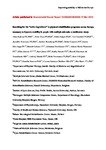Searching for the “Active Ingredients” in Physical Rehabilitation Programs Across Europe, Necessary to Improve Mobility in People With Multiple Sclerosis: A Multicenter Study
| dc.contributor.author | Kalron, A | |
| dc.contributor.author | Feys, P | |
| dc.contributor.author | Dalgas, U | |
| dc.contributor.author | Smedal, T | |
| dc.contributor.author | Freeman, Jennifer | |
| dc.contributor.author | Romberg, A | |
| dc.contributor.author | Conyers, H | |
| dc.contributor.author | Elorriaga, I | |
| dc.contributor.author | Gebara, B | |
| dc.contributor.author | Merilainen, J | |
| dc.contributor.author | Heric-Mansrud, A | |
| dc.contributor.author | Jensen, E | |
| dc.contributor.author | Jones, K | |
| dc.contributor.author | Knuts, K | |
| dc.contributor.author | Maertens de Noordhout, B | |
| dc.contributor.author | Martic, A | |
| dc.contributor.author | Normann, B | |
| dc.contributor.author | O. Eijnde, B | |
| dc.contributor.author | Rasova, K | |
| dc.contributor.author | Santoyo Medina, C | |
| dc.contributor.author | Baert, I | |
| dc.date.accessioned | 2019-03-28T16:18:50Z | |
| dc.date.available | 2019-03-28T16:18:50Z | |
| dc.date.issued | 2019-03-17 | |
| dc.identifier.issn | 1545-9683 | |
| dc.identifier.issn | 1552-6844 | |
| dc.identifier.uri | http://hdl.handle.net/10026.1/13574 | |
| dc.description.abstract |
<jats:p> Background. Physical rehabilitation programs can lead to improvements in mobility in people with multiple sclerosis (PwMS). Objective. To identify which rehabilitation program elements are employed in real life and how they might affect mobility improvement in PwMS. Methods. Participants were divided into improved and nonimproved mobility groups based on changes observed in the Multiple Sclerosis Walking Scale–12 following multimodal physical rehabilitation programs. Analyses were performed at group and subgroup (mild and moderate-severe disability) levels. Rehabilitation program elements included setting, number of weeks, number of sessions, total duration, therapy format (individual, group, autonomous), therapy goals, and therapeutic approaches. Results. The study comprised 279 PwMS from 17 European centers. PwMS in the improved group received more sessions of individual therapy in both subgroups. In the mildly disabled group, 60.9% of the improved received resistance training, whereas, 68.5% of the nonimproved received self-stretching. In the moderately-severely disabled group, 31.4% of the improved, received aerobic training, while 50.4% of the nonimproved received passive mobilization/stretching. Conclusions. We believe that our findings are an important step in opening the black-box of physical rehabilitation, imparting guidance, and assisting future research in defining characteristics of effective physical rehabilitation. </jats:p> | |
| dc.format.extent | 154596831983489-154596831983489 | |
| dc.format.medium | Print-Electronic | |
| dc.language | en | |
| dc.language.iso | en | |
| dc.publisher | SAGE Publications | |
| dc.subject | multiple sclerosis | |
| dc.subject | physical rehabilitation | |
| dc.subject | mobility | |
| dc.subject | walking | |
| dc.subject | treatment elements | |
| dc.title | Searching for the “Active Ingredients” in Physical Rehabilitation Programs Across Europe, Necessary to Improve Mobility in People With Multiple Sclerosis: A Multicenter Study | |
| dc.type | journal-article | |
| dc.type | Journal Article | |
| dc.type | Multicenter Study | |
| dc.type | Research Support, Non-U.S. Gov't | |
| plymouth.author-url | https://www.webofscience.com/api/gateway?GWVersion=2&SrcApp=PARTNER_APP&SrcAuth=LinksAMR&KeyUT=WOS:000464522100003&DestLinkType=FullRecord&DestApp=ALL_WOS&UsrCustomerID=11bb513d99f797142bcfeffcc58ea008 | |
| plymouth.issue | 4 | |
| plymouth.volume | 33 | |
| plymouth.publication-status | Published | |
| plymouth.journal | Neurorehabilitation and Neural Repair | |
| dc.identifier.doi | 10.1177/1545968319834893 | |
| plymouth.organisational-group | /Plymouth | |
| plymouth.organisational-group | /Plymouth/Faculty of Health | |
| plymouth.organisational-group | /Plymouth/Faculty of Health/School of Health Professions | |
| plymouth.organisational-group | /Plymouth/REF 2021 Researchers by UoA | |
| plymouth.organisational-group | /Plymouth/REF 2021 Researchers by UoA/UoA03 Allied Health Professions, Dentistry, Nursing and Pharmacy | |
| plymouth.organisational-group | /Plymouth/Research Groups | |
| plymouth.organisational-group | /Plymouth/Research Groups/Institute of Health and Community | |
| plymouth.organisational-group | /Plymouth/Research Groups/Plymouth Institute of Health and Care Research (PIHR) | |
| plymouth.organisational-group | /Plymouth/Users by role | |
| plymouth.organisational-group | /Plymouth/Users by role/Academics | |
| plymouth.organisational-group | /Plymouth/Users by role/Researchers in ResearchFish submission | |
| dc.publisher.place | United States | |
| dcterms.dateAccepted | 2019-02-07 | |
| dc.rights.embargodate | 2020-3-24 | |
| dc.identifier.eissn | 1552-6844 | |
| dc.rights.embargoperiod | Not known | |
| rioxxterms.versionofrecord | 10.1177/1545968319834893 | |
| rioxxterms.licenseref.uri | http://www.rioxx.net/licenses/all-rights-reserved | |
| rioxxterms.licenseref.startdate | 2019-03-17 | |
| rioxxterms.type | Journal Article/Review |


